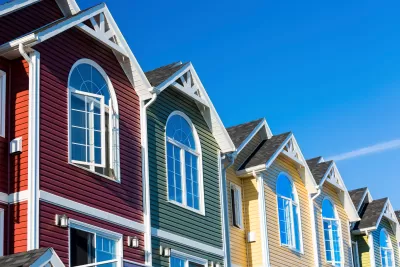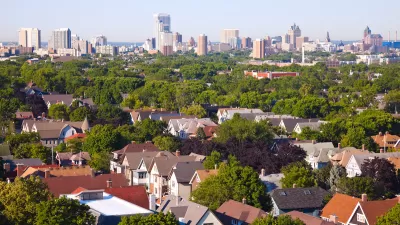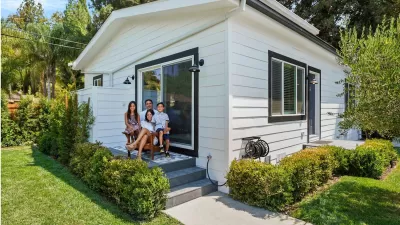A recent Zillow survey eviscerates a few myths about public opinion on housing issues, but also shows that public opinion is divided.

Zillow recently came out with a survey of public opinion on housing issues which showed that the public is generally concerned about housing issues. However, the most interesting (and divisive) questions asked respondents about their willingness to support new housing in their own neighborhoods.
In particular, residents of 29 metro areas were asked whether they were willing to support each of several housing types in their neighborhood. The least controversial housing type was accessory dwelling units; 70 percent of respondents were willing to support accessory dwelling units (ADUs). The most controversial housing type was larger apartment buildings of 50 units or more: just 38 percent of respondents were willing to support such buildings in their neighborhood.
To put it another way, public opinion seems divided into three fairly equal groups: 38 percent took the “Yes In My Back Yard” (YIMBY) position that apartments nearby were acceptable, up to 30 percent* even opposed ADUs, and the rest support ADUs but not other types of housing. The in-between group was fairly evenly divided as to other “Missing Middle housing:” as a result, small majorities favored duplexes/triplexes, and smaller apartment buildings with up to ten units (59 percent favored the former, and 52 percent favored the latter).**
These results partially disprove the idea that new housing doesn't get built because the public doesn't want it; instead, they suggest that zoning hearings where most attendees oppose new housing are not representative of the broader community. On the other hand, the even division of public opinion on some issues might explain why pro-YIMBY legislation often has difficulty at the state level: where public opinion is fairly evenly divided, risk-averse legislators may tend to favor the status quo.
Even people who would prefer new housing to be elsewhere acknowledge its value: 70 percent of people agreed that small apartment buildings would “have a positive effect” on “availability of more affordable housing options.” This means that at least 18 percent of respondents (70 percent minus the 52 percent who favored small apartment buildings in the neighborhood) favored apartments in someone else's neighborhood. To put it another way, at most 30 percent of respondents favor the "supply skeptic" idea that new housing won't reduce rents.
The Zillow survey debunks the theory that opposition to new housing is led by city residents and/or poor people concerned about gentrification. Generally, the most marginalized populations were the most willing to support new housing. For example:
- 63 percent of renters were willing to support small apartment buildings of up to 10 units, as opposed to only 46 percent of homeowners were. Similarly, 50 percent of renters supported large apartment buildings, as opposed to only a third of homeowners.
- 59 percent of Blacks were willing to support small apartment buildings, as opposed to 47 percent of whites. Similarly, 46 percent of Blacks supported the largest buildings, as opposed to a third of whites. (On the other hand, household income did not correlate strongly with support for apartments—but this may reflect the fact that wages are higher in the most expensive metro areas, so that working—and middle-class respondents were coded in moderate and high income categories).
- City residents are more pro-housing than suburbanites. 65 percent of city residents were willing to support small buildings in their neighborhood, as opposed to 46 percent of suburbanites. (For buildings with over 50 units the comparable numbers were 53 percent and 30 percent).
A related myth is that opposition to new housing is based on concerns about affordability. The Zillow website stated that among people who opposed every type of new housing listed, “Only about one in five said requiring that at least 10% of new units be affordable to low and middle income families would make them more supportive (19%, versus 57% who said it would make them more opposed).” No matter how many so-called activists try to use progressive-sounding language to defend the status quo, the reality is the most hard-core opponents of new housing are terrified by proximity to “low and middle income families."***
Moreover, pro-housing sentiment was strongest in the most expensive metros. Fewer than 30 percent of respondents favored larger apartment buildings in Baltimore, Jacksonville, St. Louis, Nashville, Raleigh, and Tampa: all Sunbelt and Rust Belt metros with ordinary or lower than average costs. By contrast, over 40 percent did so in New York, Seattle, Washington, Miami and Los Angeles—all areas with higher than average housing costs. In all of the latter five metros, support for small apartment buildings was slightly higher than the national average. By contrast, the only metros where fewer than 40 percent of respondents favored small apartment buildings were Nashville, Baltimore and Jacksonville—all metros that are not insanely expensive. (On the other hand, since the 14,000 adults surveyed were spread out over 29 metros, it may be that metro-by-metro sample sizes were too small to be reliable).
To put it another way: the people with the most reason to be concerned about rising housing costs (such as renters, residents of more costly metros) are the most likely to support new housing.
*I say “up to” because the Zillow article about the poll did not say how many respondents were undecided.
**Oddly, support for fourplexes and sixplexes were slightly larger than support for small apartment buildings: I cannot explain this result.
***I note, however, that Zillow asserts that most respondents (over 3/4 even as to large apartment buildings) claimed that either affordability, proximity to transit, or proximity to recreation would make them more supportive of new housing. However, Zillow's story about their survey did not break down the importance of each of these factors, nor did it say how many people would be less supportive of new housing under these circumstances.

Alabama: Trump Terminates Settlements for Black Communities Harmed By Raw Sewage
Trump deemed the landmark civil rights agreement “illegal DEI and environmental justice policy.”

Study: Maui’s Plan to Convert Vacation Rentals to Long-Term Housing Could Cause Nearly $1 Billion Economic Loss
The plan would reduce visitor accommodation by 25% resulting in 1,900 jobs lost.

Why Should We Subsidize Public Transportation?
Many public transit agencies face financial stress due to rising costs, declining fare revenue, and declining subsidies. Transit advocates must provide a strong business case for increasing public transit funding.

Wind Energy on the Rise Despite Federal Policy Reversal
The Trump administration is revoking federal support for renewable energy, but demand for new projects continues unabated.

Passengers Flock to Caltrain After Electrification
The new electric trains are running faster and more reliably, leading to strong ridership growth on the Bay Area rail system.

Texas Churches Rally Behind ‘Yes in God’s Back Yard’ Legislation
Religious leaders want the state to reduce zoning regulations to streamline leasing church-owned land to housing developers.
Urban Design for Planners 1: Software Tools
This six-course series explores essential urban design concepts using open source software and equips planners with the tools they need to participate fully in the urban design process.
Planning for Universal Design
Learn the tools for implementing Universal Design in planning regulations.
Caltrans
Smith Gee Studio
Institute for Housing and Urban Development Studies (IHS)
City of Grandview
Harvard GSD Executive Education
Toledo-Lucas County Plan Commissions
Salt Lake City
NYU Wagner Graduate School of Public Service






























